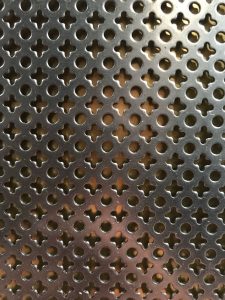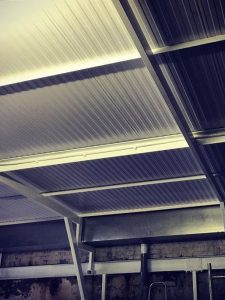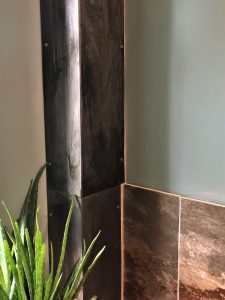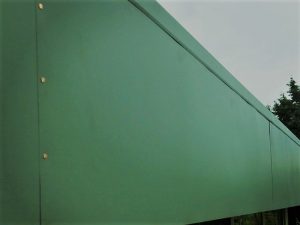The growing use of metal in our gardens, where functionality, aesthetics and symbolism fuse
June 10, 2018Cladding is the name of the game
(This blog is well overdue…I blame the summer holidays and kids being under my feet!!)
We are currently working on a lovely cladding job for a client, to refurbish a kitchen and revamp part of a bathroom. The client noticed images from our Insta feed on previous cladding jobs and knew it was something she wanted to build on the character of her beautiful home. It got me thinking about the uses of cladding in its continuing versatility…the way it functions, covers, manipulates and creates diversity in varying spaces. But what is it about a simple sheet of metal that can be so alluring?
What is cladding some of you may ask?
It is layering or covering of one material over another to create protection and insulation. In terms of the cladding LCR supplies or has been asked to make it is largely decorative. Wall coverings to produce a contrasting backdrop, kitchen and bathroom worktops for a particularly sturdy, industrial feel. Exterior cladding to enhance a buildings appearance and compliment the surrounding area. We have also clad surfaces out of necessity, to cover unseemly boxed sections or to reinforce broken structures. In our own property we were asked late on in the renovations to install two large steel posts to reinforce the footings of the property. We were lumbered with steel posts in odd places with no way around but to box in and then clad with cold rolled mild steel. The sheets were washed in Mordant solution to produce an interesting and varying hue on the steel. Cold roll is a clean, durable material with an even consistency (no mill scale) with an extremely high yield strength. The posts are now key features within their own space, almost sculptural and on show yet blending into the form of the room.
Which materials work where?
Internally materials such as brass, copper and mild steel hold a particular aesthetic. The colour, patina and texture can give a room warmth and depth, allowing a rich vibrancy to shine through compared to and working alongside other raw materials such as concrete, ceramic and wood. These materials offer a sort of iridescent appearance, a soft sheen, a gleam across their surface. Seemingly changing in appearance but being resolutely strong, resilient, and durable. They will not chip or scratch or dent and are therefore great in high impact areas (with children) or places of heavy use.
Externally materials that can suffer the elements are great barriers for buildings whilst providing a distinct architectural display. Zinc, corten, brass, copper and aluminium are often used for external cladding. They all, in one form or another, exhibit several advantages when used externally;
- When fixed they require little if no form of upkeep or maintenance
- They do not absorb moisture, and are therefore resistant to algae and fungi
- There appearance will remain unchanged for years
- They are resistant to fires
- They provide adequate insulation, making buildings more energy efficient
- Metals are malleable, they can be formed into all shapes, ideal for contemporary builds
- They come in a variety of colours and textures
- Exterior cladding is widely available and easy to install
In addition, copper has health benefits. This metal is imbued with healing properties that ward off any nasty bacteria through contact. The copper emits ions, which (don’t quote me on the specific science-y stuff) react with oxygen and hydrogen peroxide given off by the nasty bacteria. This reaction causes an attack on any harmful microbes, viruses, bacteria, germs, etc…killing them almost immediately. I mean it’s a no brainer, everyone needs copper cladding in their house if only to prevent a snotty cold. That, and it looks superb. The deep lustre of copper brings true depth to any space. The rich pinkish, orange hue will change over time, due to slow oxidisation, to a deep, dull brown. This process can be slowed by polishing the copper, which when done slowly and respectfully can display the beautiful layers, colours and history of this lustrous metal.
We love Zinc
Zinc is increasingly used for cladding. It is the go-to material of many architects and designers. Its benefits, when used externally, outweigh most other metals simply for its non-corrosive quality. Zinc has the ability to resist erosion due to the protective layer of zinc carbonate it forms on the surface when exposed to moisture and carbon dioxide in our atmosphere. The resulting effect is a beautiful greyish, blue opalescent patina. Zinc can happily protect a building for over 60 years without little maintenance, in fact this metal is self-healing. As the patination process continues from year to year, the surface of the zinc will rejuvenate and replenish so that any scratches or blemishes that once were present will no longer be visible. It’s a miracle metal!! Zinc is also environmentally friendly. It is 100% recyclable and can be used over and over again.
Zinc however, can be an expensive material. Unless used on big build projects people tend to shy away from it for this single reason. As a cheaper alternative there is Zintec sheet, which has the same surface attributes but not the same non-corrosive qualities. We tend to use zintec for internal decorative projects, for furniture, table worktops, sheet metal enclosures and cabinets. Items that might rust if made from mild steel but that do not need the full Zinc treatment!
I have only touched on some minor aspects of cladding, the ins and outs of its characteristics and qualities in a very loose way. Each metal deserves a much bigger platform to fully shine and be heard. Watch this space…maybe that’s my future blogs sorted!





